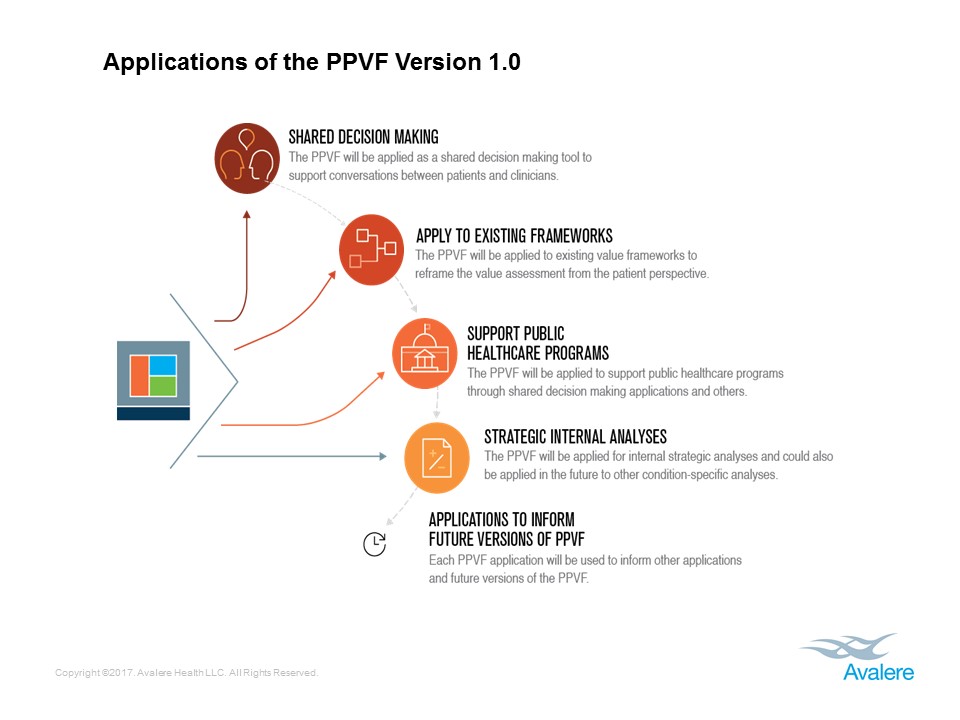Avalere and FasterCures Release Patient-Perspective Value Framework to Incorporate Patient Preferences into Healthcare Treatment Decisions
Summary
Today, Avalere and FasterCures published Version 1.0 of the Patient-Perspective Value Framework (PPVF).The PPVF is a new way to assess the value of healthcare services that considers factors that matter to patients—such as functional and cognitive status, symptom relief, complexity of regimen, and medical as well as non-medical out-of-pocket costs to the patient and family—and weights them in accordance with assessed patient preferences.
The PPVF Framework comprises five domains: patient preferences, patient-centered outcomes, patient and family costs, usability and transparency, and quality and application of evidence (Figure 1). The patient preferences domain serves as a lens through which PPVF views the outcomes, cost, and quality and applicability components. These domains were selected by a 23-member PPVF steering committee that represent engagement from a diverse group of healthcare stakeholders including federal government agencies, patient groups, health plans, providers, life sciences companies, and others.
“As the U.S. healthcare system transitions to value-based payment, it is imperative that we get the value definition right and measure what truly matters to the patient,” said Josh Seidman, senior vice president in Avalere’s Center for Payment and Delivery Innovation®. “The PPVF identifies what matters to patients and enables healthcare organizations to integrate this insight into their payment systems. We look forward to the next phases of the PPVF Initiative, where we’ll integrate these learnings into real-world applications in different health systems.”
The PPVF will (Figure 2):
Avalere, FasterCures, and other partners will also leverage the PPVF Version 1.0 to further their goals of patient-centered value assessment through related projects.
- Inform shared decision-making between patients and clinicians;
- Apply to existing frameworks to incorporate patient preferences into value assessments;
- Support public health care programs, including efforts by the Centers for Medicare and Medicaid Services to pay for quality and promote shared decision making; and,
- Generate internal analyses to inform strategic recommendations to drive patient-centered drug development.
The PPVF Initiative began in response to a proliferation of value frameworks and public concern that existing approaches did not adequately incorporate the patient perspective on value. Because of this, working with other framework developers is a key focus of Phase II of the PPVF Initiative, which starts in June 2017 and is again being supported by seed funding from FasterCures and a diverse group of stakeholders.
“FasterCures, Avalere, and each member of the PPVF Steering Committee wanted to bring patients to the center of the broader conversation going on in biomedical R&D about the value of healthcare. This focus on the patient, all while part of a collaborative, multi-stakeholder process, has resulted in a framework that not only reflects the patient voice but also will enable us to redefine value in all facets of health care, from drug development to clinical decision making,” said Margaret Anderson, executive director of FasterCures, a center of the Milken Institute.
The PPVF Initiative is collaborating with other framework developers to find opportunities to make their frameworks more patient centered. At the February PPVF Steering Committee meeting, representatives from the Institute for Clinical and Economic Review, the American Society of Clinical Oncology, the National Comprehensive Cancer Network, and Memorial Sloan Kettering’s DrugAbacus joined the steering committee for a discussion of how the PPVF relates to their frameworks. The conversation set a collaborative tone for continued engagement throughout Phase II of the PPVF Initiative.
Background on the PPVF Initiative
Leveraging seed funding from FasterCures, Avalere formed the PPVF steering committee in June 2016. Twenty-three organizations, including life sciences companies, patient groups, payers, and others including research institutes like the Patient Centered Outcomes Research Institute, worked together to develop the PPVF Version 1.0. As a group, the PPVF steering committee agreed on five broad domains of patient value, specific criteria that matter to patients when making treatment decisions, and a method for assessing those criteria and domains. Avalere, FasterCures, and the PPVF steering committee released a draft for public input in November 2016.
That request for input generated nearly 100 comments on the draft PPVF from patients, patient advocates, researchers, and others. In January, patient groups on the steering committee—including the Cancer Support Community, the Partnership for Improved Patient Care, the National Health Council, the American Heart Association/American Stroke Association and the Michael J. Fox Foundation—collaborated to solicit input directly from their membership through targeted surveys, focus groups, and roundtable discussions. In all, we received input from 270 people and organizations, with more than 80% of that input coming directly from patients. This feedback informed revisions to the draft PPVF, leading to the PPVF Version 1.0 released today.
Download a printer-friendly version of the PPVF summary infographic (designed to be printed on 11×17 paper).








